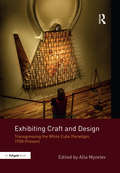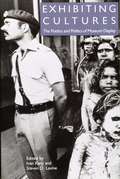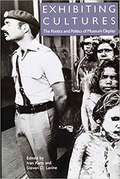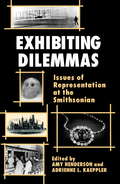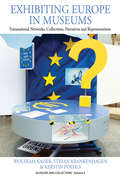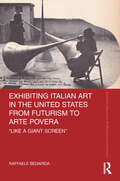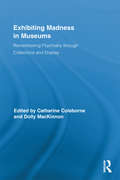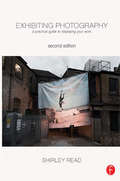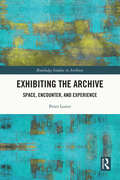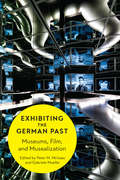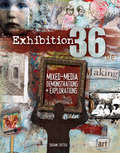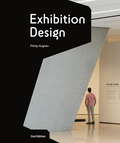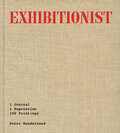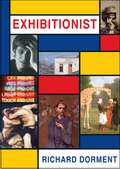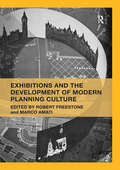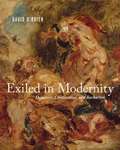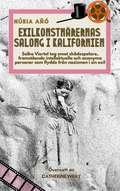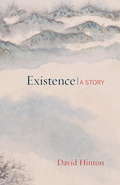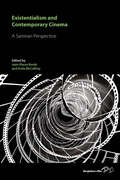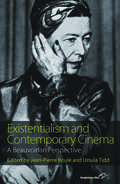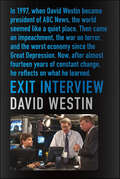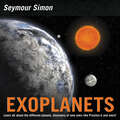- Table View
- List View
Exhibiting Craft and Design: Transgressing the White Cube Paradigm, 1930–Present
by Alla MyzelevExhibiting Craft and Design: Transgressing the White Cube Paradigm, 1930–present investigates the ways that craft and design objects were collected, displayed, and interpreted throughout the second half of the twentieth century and in recent years. The case studies discussed in this volume explain the notion the neutral display space had worked with, challenged, distorted, or assisted in conveying the ideas of the exhibitions in question. In various ways the essays included in this volume analyse and investigate strategies to facilitate interaction amongst craft and design objects, their audiences, exhibiting bodies, and the makers. Using both historical examples from the middle of the twentieth century and contemporary trends, the authors create a dialogue that investigates the different uses of and challenges to the White Cube paradigm of space organization.
Exhibiting Cultures: The Poetics and Politics of Museum Display
by Ivan KarpDebating the practices of museums, galleries, and festivals, Exhibiting Cultures probes the often politically charged relationships among aesthetics, contexts, and implicit assumptions that govern how art and artifacts are displayed and understood. The contributors--museum directors, curators, and scholars in art history, folklore, history, and anthropology--represent a variety of stances on the role of museums and their function as intermediaries between the makers of art or artifacts and the eventual viewers.From the Trade Paperback edition.
Exhibiting Cultures: The Poetics and Politics of Museum Display
by Ivan KarpDebating the practices of museums, galleries, and festivals, Exhibiting Cultures probes the often politically charged relationships among aesthetics, contexts, and implicit assumptions that govern how art and artifacts are displayed and understood. The contributors—museum directors, curators, and scholars in art history, folklore, history, and anthropology—represent a variety of stances on the role of museums and their function as intermediaries between the makers of art or artifacts and the eventual viewers.
Exhibiting Dilemmas: Issues of Representation at the Smithsonian
by Adrienne L. Kaeppler Amy HendersonIn twelve essays on such diverse Smithsonian Institution holdings as the Hope Diamond, the Wright Flyer, wooden Zuni carvings, and the Greensboro, North Carolina Woolworth lunch counter that became a symbol of the Civil Rights movement, Exhibiting Dilemmas explores a wide range of social, political, and ethical questions faced by museum curators in their roles as custodians of culture. Focusing on the challenges posed by the transformation of exhibitions from object-driven "cabinets of curiosities" to idea-driven sources of education and entertainment, the contributors--all Smithsonian staff members--provide a lively and sometimes provocative discussion of the increasingly complex enterprise of acquiring and displaying objects in a museum setting.
Exhibiting Europe in Museums: Transnational Networks, Collections, Narratives, and Representations
by Stefan Krankenhagen Kerstin Poehls Wolfram KaiserMuseums of history and contemporary culture face many challenges in the modern age. One is how to react to processes of Europeanization and globalization, which require more cross-border cooperation and different ways of telling stories for visitors. This book investigates how museums exhibit Europe. Based on research in nearly 100 museums across the Continent and interviews with cultural policy makers and museum curators, it studies the growing transnational activities of state institutions, societal organizations, and people in the museum field such as attempts to Europeanize collection policy and collections as well as different strategies for making narratives more transnational like telling stories of European integration as shared history and discussing both inward and outward migration as a common experience and challenge. The book thus provides fascinating insights into a fast-changing museum landscape in Europe with wider implications for cultural policy and museums in other world regions.
Exhibiting Italian Art in the United States from Futurism to Arte Povera: 'Like a Giant Screen' (Routledge Research in Art Museums and Exhibitions)
by Raffaele BedaridaThis volume explores how Italian institutions, dealers, critics, and artists constructed a modern national identity for Italy by exporting – literally and figuratively – contemporary art to the United States in key moments between 1929 and 1969. From artist Fortunato Depero opening his Futurist House in New York City to critic Germano Celant launching Arte Povera in the United States, Raffaele Bedarida examines the thick web of individuals and cultural environments beyond the two more canonical movements that shaped this project. By interrogating standard narratives of Italian Fascist propaganda on the one hand and American Cold War imperialism on the other, this book establishes a more nuanced transnational approach. The central thesis is that, beyond the immediate aims of political propaganda and conquering a new market for Italian art, these art exhibitions, publications, and the critical discourse aimed at American audiences all reflected back on their makers: they forced and helped Italians define their own modernity in relation to the world’s new dominant cultural and economic power. The book will be of interest to scholars working in art history, social history, exhibition history, and Italian studies.
Exhibiting Madness in Museums: Remembering Psychiatry Through Collection and Display (Routledge Research in Museum Studies)
by Catharine Coleborne Dolly MacKinnonWhile much has been written on the history of psychiatry, remarkably little has been written about psychiatric collections or curating. Exhibiting Madness in Museums offers a comparative history of independent and institutional collections of psychiatric objects in Australia, New Zealand, Canada and the United Kingdom. Leading scholars in the field investigate collectors, collections, their display, and the reactions to exhibitions of the history of insanity. Linked to the study of medical museums this work broadens the study of the history of psychiatry by investigating the significance and importance of the role of twentieth-century psychiatric communities in the preservation, interpretation and representation of the history of mental health through the practice of collecting. In remembering the asylum and its different communities in the twentieth century, individuals who lived and worked inside an institution have struggled to preserve the physical character of their world. This collection of essays considers the way that collections of objects from the former psychiatric institution have played a role in constructions of its history. It historicises the very act of collecting, and also examines ethical problems and practices which arise from these activities for curators and exhibitions.
Exhibiting Photography: A Practical Guide to Displaying Your Work
by Shirley ReadYou have the camera, you have the skills, and you have the pictures. Now what? Author Shirley Read expertly leads you through the world of exhibiting your photography one minute detail at a time. From finding a space and designing the exhibition to actually constructing a show and publicizing yourself, every aspect of exhibiting your photography is touched upon and clarified with ample detail, anecdotes, and real life case studies. In this new and expanded second edition, Shirley Read further illuminates the world of social networking, exhibiting, and selling photography online so your work is always shown in the best light. Packed with photos of internationally successful exhibitions, check lists, and invaluable advice, this essential reference guide will help amateur and professional photographers alike successfully showcase their bodies of work with confidence and finesse.
Exhibiting the Archive: Space, Encounter, and Experience (Routledge Studies in Archives)
by Peter LesterExhibiting the Archive examines the role that exhibition plays in archives and analyses the impact they are understood to have on how users and visitors experience the archive. Drawing on research conducted in Europe, North America and Australia, the book analyses the key theoretical and social influences on exhibition-making in archives today and discusses the role of exhibitions in the archives of tomorrow. This is the first in-depth study to consider exhibition as more than outreach or advocacy: it frames exhibition as an encounter with archives and with people, and interprets it as a mechanism for change within the archive. Against a backdrop of increasing digital activity, Lester asks what experience within the physical space of the archive could be. Drawing on ideas of spatiality and embodiment, as well as social justice and activism, Lester considers the role of exhibitions within the physical archive and the part they can play in reshaping how experience is understood to happen within it. Exhibiting the Archive offers a new perspective on the archive that will be of interest to academics and students engaged in the study of archives and records. The discussions of cutting-edge practice offer new insights into how exhibitions are conceived and made, and will therefore be of interest to practitioners around the world.
Exhibiting the German Past
by Peter M. Mcisaac Gabriele MuellerWhile scholars recognize both museums and films as sites where historical knowledge and cultural memory are created, the convergence between their methods of constructing the past has only recently been acknowledged. The essays in Exhibiting the German Past examine a range of films, museums, and experiences which blend the two, considering how authentic objects and cinematic techniques are increasingly used in similar ways by both visual media and museums.This is the first collection to focus on the museum-film connection in German-language culture and the first to approach the issue using the concept of "musealization," a process that, because it engages the cultural destruction wrought by modernization, offers new means of constructing historical knowledge and shaping collective memory within and beyond the museum's walls. Featuring a wide range of valuable case studies, Exhibiting the German Past offers a unique perspective on the developing relationship between museums and visual media.
Exhibition 36: Mixed Media Demonstrations + Explorations
by Susan TuttleYou're first in line!Come inside for an amazing virtual art exhibit featuring 36 inspiring artists.There's something for everyone at this art expo. Whether you want to sharpen digital-imaging skills, make your own jewelry or listen to the stories behind provocative works, you're sure to find plenty to keep you busy - all included with the price of admission. Amidst a full-color feast for your eyes, you will:Discover ways to turn your art "mistakes" into meaningful creationsSit in on mixed-media demonstrations, guiding you through techniques for layering, transferring, altering and moreBe introduced to the works and inspiration of 36 artists, including: Lisa Falzon, Sheri Gaynor, Claudine Hellmuth, Katie Kendrick, Deryn Mentock, Karen Michel, Ted Orland, Izabella Pierce, Richard Salley, Suzanne Simanaitis, Roben-Marie Smith, Jonathan Talbot and many more!Take on creative challenges to push your art-making into new directionsEnter the Exhibition 36 experience - your ticket to an amazing gallery of mixed-media inspiration.
Exhibition Design Second Edition: An Introduction
by Philip HughesExhibition Design describes the skills needed to become an exhibition designer, including: developing a brief and working with clients; design principles for graphics, circulation, lighting, and accessibility; presenting ideas to clients; and the practicalities of production. A wealth of visual material includes photographs of completed exhibitions by world-renowned designers, concept drawings, computer renderings, charts and tables of information – all for a wide range of exhibitions around the world, permanent and temporary, including museums and galleries, visitor centres, brand experiences, festivals, and trade fairs. This second edition includes new examples, updated information on the latest digital technology, and expanded coverage of interactives and sound and film.
Exhibition Design Second Edition: An Introduction
by Philip HughesExhibition Design describes the skills needed to become an exhibition designer, including: developing a brief and working with clients; design principles for graphics, circulation, lighting, and accessibility; presenting ideas to clients; and the practicalities of production. A wealth of visual material includes photographs of completed exhibitions by world-renowned designers, concept drawings, computer renderings, charts and tables of information – all for a wide range of exhibitions around the world, permanent and temporary, including museums and galleries, visitor centres, brand experiences, festivals, and trade fairs. This second edition includes new examples, updated information on the latest digital technology, and expanded coverage of interactives and sound and film.
Exhibitionist: 1 Journal, 1 Depression, 100 Paintings
by Peter MendelsundFrom acclaimed designer and novelist Peter Mendelsund, a deeply personal reflection on depression and the redemptive power of art, interspersed with 100 original paintingsIn the early days of the pandemic, Peter Mendelsund and his family traveled up to a secluded New Hampshire farmhouse to weather the chaos. There began his journey through a crippling and seemingly intractable depression—which differed in degree but not in kind from episodes that have recurred periodically throughout his life—that brought him to the brink of suicide. Relief came from an unlikely source: painting, something Peter had never contemplated doing before. And yet it became the thing that may very well have saved his life. Bleakly funny, profoundly moving, and—against all odds—truly inspiring, Exhibitionist is not just an account of a mind thinking through its own suffering in real-time, and of the author&’s reckoning with his father's tortured legacy; it's also the story of the birth of an artist, and a portrait of an artist at work.
Exhibitionist: Writing about Art in a Daily Newspaper
by Richard Dorment100 sumptuously produced essays by Britain's leading art critic, US born, Richard Dorment. They cover exhibitions of historic and contemporary art world-wide, interpreting and critiquing many of the most important shows of the last 30 years. They offer, in a highly accessible form, the fundamental elements of a history of art, and a beguiling review of recent cultural trends.
Exhibitions and the Development of Modern Planning Culture
by Robert Freestone Marco AmatiThe evolution of city planning theory and practice in the first half of the twentieth century was captured and driven by a range of exhibitionary practices in a variety of settings globally, from international expos to local public halls. The agendas of the promoters varied, but exhibitions generally drew their social legitimacy from their status as ’appropriate educative agencies of citizenship’. Bringing together a range of international case studies, this volume explores the highly visual genre of public planning exhibitions worldwide. In doing so, it provides a unique lens on the development of modern urban planning and design from the late 19th century to the present day. Focussing mainly on the first half of the 20th century, it looks in particular at historic exhibitions which sought to transform urban society’s understanding of the possibilities of planning as a force for social betterment. The visuality of presentation, contemporary reactions, and outcomes for the planning profession and the community are explored to make for a unique, innovative and attractive approach to the history of planning ideas. The five major themes are the visual representation of ideas and ideologies; institutions and individuals involved; the broader context of display; and the impacts and implications for the development planning culture. With contributors including Karl Fischer, John Gold, Carola Hein, Peter Larkham, Javier Monclus, and Mark Tewdwr-Jones, the dominant intellectual paradigm further unifying the collection is planning history.
Exiled in Modernity: Delacroix, Civilization, and Barbarism
by David O'BrienNotions of civilization and barbarism were intrinsic to Eugène Delacroix’s artistic practice: he wrote regularly about these concepts in his journal, and the tensions between the two were the subject of numerous paintings, including his most ambitious mural project, the ceiling of the Library of the Chamber of Deputies in the Palais Bourbon. Exiled in Modernity delves deeply into these themes, revealing why Delacroix’s disillusionment with modernity increasingly led him to seek spiritual release or epiphany in the sensual qualities of painting. <p><p> While civilization implied a degree of control and the constraint of natural impulses for Delacroix, barbarism evoked something uncontrolled and impulsive. Seeing himself as part of a grand tradition extending back to ancient Greece, Delacroix was profoundly aware of the wealth and power that set nineteenth-century Europe apart from the rest of the world. Yet he was fascinated by civilization’s chaotic underbelly. In analyzing Delacroix’s art and prose, David O’Brien illuminates the artist’s effort to reconcile the erudite, tradition-bound aspects of painting with a desire to reach viewers in a more direct, unrestrained manner. <p> Focusing chiefly on Delacroix’s musings about civilization in his famous journal, his major mural projects on the theme of civilization, and the place of civilization in his paintings of North Africa and of animals, O’Brien links Delacroix’s increasingly pessimistic view of modernity to his desire to use his art to provide access to a more fulfilling experience.With more than one hundred illustrations, this original, astute analysis of Delacroix and his work explains why he became an inspiration for modernist painters over the half-century following his death. Art historians and scholars of modernism especially will find great value in O’Brien’s work.
Exiled in Modernity: Delacroix, Civilization, and Barbarism
by David O'BrienNotions of civilization and barbarism were intrinsic to Eugène Delacroix’s artistic practice: he wrote regularly about these concepts in his journal, and the tensions between the two were the subject of numerous paintings, including his most ambitious mural project, the ceiling of the Library of the Chamber of Deputies in the Palais Bourbon. Exiled in Modernity delves deeply into these themes, revealing why Delacroix’s disillusionment with modernity increasingly led him to seek spiritual release or epiphany in the sensual qualities of painting.While civilization implied a degree of control and the constraint of natural impulses for Delacroix, barbarism evoked something uncontrolled and impulsive. Seeing himself as part of a grand tradition extending back to ancient Greece, Delacroix was profoundly aware of the wealth and power that set nineteenth-century Europe apart from the rest of the world. Yet he was fascinated by civilization’s chaotic underbelly. In analyzing Delacroix’s art and prose, David O’Brien illuminates the artist’s effort to reconcile the erudite, tradition-bound aspects of painting with a desire to reach viewers in a more direct, unrestrained manner. Focusing chiefly on Delacroix’s musings about civilization in his famous journal, his major mural projects on the theme of civilization, and the place of civilization in his paintings of North Africa and of animals, O’Brien links Delacroix’s increasingly pessimistic view of modernity to his desire to use his art to provide access to a more fulfilling experience.With more than one hundred illustrations, this original, astute analysis of Delacroix and his work explains why he became an inspiration for modernist painters over the half-century following his death. Art historians and scholars of modernism especially will find great value in O’Brien’s work.
Exilkonstnärernas salong i Kalifornien: Salka Viertel tog emot skådespelare och intellektuella som flydde från nazismen i sin exil
by Núria Añó"Exilkonstnärernas salong i Kalifornien" är en biografi om Salka Viertel, en judisk skådespelerska som emigrerade till Hollywood och blev populärt känd som manusförfattaren till den svenska skådespelerskan Greta Garbo. Dessutom hade hon en salong i Santa Monica, Kalifornien, där en stor del av den europeiska exilintelligentsian samlades. Salka var en mycket modern och intressant kvinna för sin tid, och hon förtjänar att bli känd som hon verkligen är värd. I boken behandlas ämnen som den påstådda bisexualiteten hos Salka Viertel och de många erkända vänner hon hade, såsom Albert Einstein, Charles Chaplin, Sergei Eisenstein, F. W. Murnau, Max Reinhardt, Arnold Schönberg, Thomas Mann, Bertolt Brecht, Greta Garbo, Montgomery Clift, för att nämna några. Liksom Gertrude Stein och andra framstående kvinnor hade hon dessutom sin egen litterära salong, där författare som Truman Capote, Christopher Isherwood, Gore Vidal och många fler deltog. Andra ämnen som tas upp är Berlin på 1920-talet; övergången från stumfilm till ljudfilm, sett från filmens mecka, Hollywood. Sedan Hitlers uppgång och vad det innebar för den judiska situationen; exilen för de intellektuella som inte kunde återvända till sina respektive länder på grund av andra världskriget. Senare, kalla kriget och häxjakten mot kommunismen. Faktum är att Salka Viertels liv och hennes vänners krets berör de stora händelserna under 1900-talet. För detta projekt erhöll författaren stipendier från Shanghai Writing Program (Kina, 2016) och Baltic Centre (Sverige, 2017). "Trots att Salka Viertel var en så central gestalt i exilsamhället, har det skrivits väldigt lite om henne, vilket gör Núria Añós bok till ett korrektiv, och hon fyller många av luckorna i Främlingarna på Mabery Road." —Dialog International "En mycket intressant berättelse och jag tycker fortfarande att den är mycket aktuell, eftersom vi enligt min mening inte har ko
Existence
by David Hinton"Join David Hinton on an exploration of the entire nature of reality-an ambitious project for such a compact book, and even more amazing when you see that this cosmic journey happens all within the exploration of a single Chinese landscape painting. The painting called Peaceful-Distance Pavilion by Shih-t'ao (1642-1707) is, like other paintings in that genre, mostly space- one tiny figure, accompanied by an attendant, looks out over a vast landscape of mountains and clouds. But start looking into that space and, with the right guidance, what you end up seeing is profound. David Hinton is the perfect guide. He uses his knowledge of Chinese philosophy, poetry, art, language, and writing system to illuminate this painting's message, which is ultimately the story of the glorious dance between nothing and everything, between emptiness and existence. It's an enthralling journey that can change the way you look at the world, a journey for which David is a wise and eloquent guid"
Existentialism And Contemporary Cinema
by Enda Mccaffrey Jean-Pierre BoulaAt the heart of this volume is the assertion that Sartrean existentialism, most prominent in the 1940s, particularly in France, is still relevant as a way of interpreting the world today. Film, by reflecting philosophical concerns in the actions and choices of characters, continues and extends a tradition in which art exemplifies the understanding of existentialist philosophy. In a scholarly yet accessible style, the contributors exploit the rich interplay between Sartre's philosophy, plays and novels, and a number of contemporary films including No Country for Old Men, Lost in Translation and The Truman Show, with film-makers including the Dardenne brothers, Michael Haneke, and Mike Leigh. This volume will be of interest to students who are coming to Sartre's work for the first time and to those who would like to read films within an existentialist perspective.
Existentialism and Contemporary Cinema
by Ursula Tidd Jean-Pierre BouleSimone de Beauvoir's work has not often been associated with film studies, which appears paradoxical when it is recognized that she was the first feminist thinker to inaugurate the concept of the gendered 'othering' gaze. This book is an attempt to redress this balance and reopen the dialogue between Beauvoir's writings and film studies. The authors analyse a range of films, from directors including Claire Denis, Michael Haneke, Lucille Hadzihalilovic, Sam Mendes, and Sally Potter, by drawing from Beauvoir's key works such as The Second Sex (1949), The Ethics of Ambiguity (1947) and Old Age (1970).
Exit Interview
by David WestinWhen David Westin became president of ABC News in March 1997, the division was treading water. "It looked like all the really important news was behind us," he writes. Hardly. For the next thirteen years, Westin would preside over ABC News during some of the most important and perplexing events in its history:• President Clinton's impeachment• The tied 2000 presidential election• The 9/11 attacks• Conflicts in Iraq and Afghanistan• The swift boat smear campaign against Senator John KerryExit Interview is a behind-the-scenes look at Westin's tenure and the major news that marked it. He takes us inside the chaos of the newsroom—alongside major players such as Peter Jennings, Barbara Walters, Diane Sawyer, and Bob Woodruff—where what looks clear and certain from the outside is often mired in conflict and urgency. Neither an apologia nor a critique, the book charts the ups and downs of fourteen formative years in network news, addressing basic questions about how our news is reported, from the point of view of someone who was there. With milestones from the recent past, Westin explores the uncertainty inherent in his job, and its central question: Is it possible for journalists to be both good at their jobs and people of good moral character?
Exits and Entrances: Interviews with Seven Who Reshaped African-American Images in Movies
by Frank Manchel“A worthy successor to Every Step a Struggle . . . the contributions to American cinema of these determined and courageous rebels will never be forgotten.” —Denise Youngblood, author ofCinematic Cold WarWhile Every Step a Struggle recalled the performers who fought to give black artists a voice and a presence in film and on stage, this new ground-breaking book focuses on the personalities who replaced the pioneers and refused to abide by Jim Crow traditions. Presented against a detailed background of the revolutionary post-World War II era up to the mid-1970s, the individual views of Mae Mercer, Brock Peters, Jim Brown, Ivan Dixon, James Whitmore, William Marshall and Ruby Dee in heretofore unpublished conversations from the past reveal just how tumultuous and extraordinary the technological, political, and social changes were for the artists and the film industry. Using extensive documentation, hundreds of films, and fascinating private recollections, Dr. Manchel puts a human face both on popular culture and race relations.“Using the method of oral history and the mature thinking of a senior scholar, Exits and Entrances enhances our understanding of the difficult slog to create a truthful, ‘round’ image of African-Americans in U.S. commercial films. This collection is a gold mine of information for future research and should be in all libraries which value film research.” —Peter C. Rollins, Emeritus Editor-in-Chief of Film & History
Exoplanets
by Seymour SimonAward-winning science writer Seymour Simon explores the farthest reaches of space in the brand-new Exoplanets! This nonfiction picture book is an excellent choice to share during homeschooling, in particular for children ages 6 to 8. It’s a fun way to learn to read and as a supplement for activity books for children.There are thousands of exoplanets scattered throughout the Milky Way galaxy, and scientists are on a constant quest to find one just like Earth. In Exoplanets, Simon examines the planets outside of our solar system and uncovers what makes them habitable, our efforts to discover new life, and more.With clear, simple text and stunning full-color photographs, readers will explore the farthest reaches of space and explore the answer to the question: do aliens exist?This book includes an author's note, a glossary, an index, and supports the Common Core State Standards.
